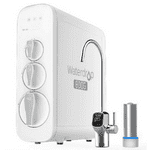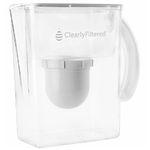Lead is a devastating toxin — no amount is safe to drink, especially for children. Yet more than 20 million Americans have more than the recommended limit in their water because of aging infrastructure and lead plumbing in older homes.
It could take decades for communities to find a solution, so the only way to safeguard your family today is with a water filter. But don’t settle for models that remove “up to” 99-percent of lead. These top performers are the best protection money can buy.
So Let’s get to it
#1 is my favorite, but #2 and #8 are best overall for the money…
Expert Picks:
- Best Overall: SpringWell Lead & Cyst System
- Best Budget: PUR Faucet Filter
- Best Reverse Osmosis: Waterdrop G3P800 RO System
- Best Countertop: Big Berkey 2.25 Gal Filter
- Best Under Sink: Aquasana Claryum Direct Filter
- Best Filter Pitcher: Epic Pure Pitcher
- Best Countertop RO: AquaTru RO Countertop System
- Best Direct Connect: Aquasana OptimH2O RO + Claryum Filter
#1. SpringWell Whole House Lead and Cyst Removal System
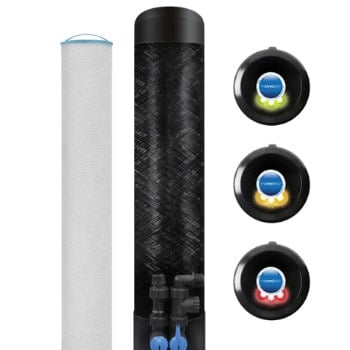
SpringWell’s whole-home lead filtration system removes more than 99.95-percent of lead and chlorine.
NSF/ANSI P473 and 53 certified, the 0.5-micron filter eliminates parasitic cysts and reduces dangerous forever-chemicals, including PFOA and PFOS.
Your water will be safer and taste better than bottled.
- Virtually eliminates lead from source water and service lines
- Whole-home filtration provides clean water at every tap
- Low-maintenance
- Won’t impact water pressure
- Limited lifetime warranty
Use Coupon Code: QWL5 to save!
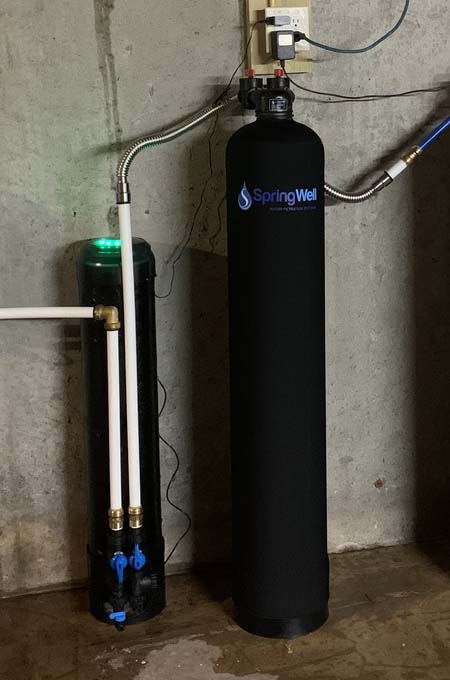

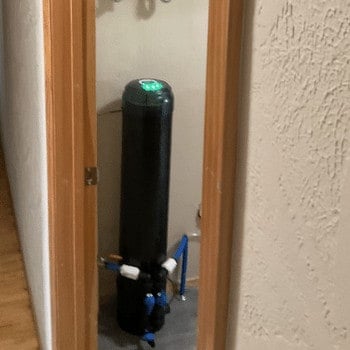
Great For: This is great for anyone looking to get lead-free water from every source in your home.
Pros
- The system treats 100,000 gallons of water between filter changes — enough for a family of four for a year. Just set it and forget it.
- The PIONEER digital head monitors water usage and warns you when filter life is low.
- Timely maintenance is critical for optimal lead removal, but unlike some systems that leave you guessing when filters are spent, you won’t miss a beat with the SpringWell. It’s satisfaction-guaranteed.
- Lead is scary stuff. It’s tasteless, colorless and odorless.
- If you have aging underground pipes in your area, lead is a threat, and no filter removes more of it than the SpringWell.
- The upfront price is high, but it’s a bargain for this level of quality, performance and convenience.
- Ultra-low-maintenance and third-party certified, it’s backed by a company committed to clean water.
- For my money, it’s the best for lead removal and is our number #1 top rated whole house water filter.
- Filters are simple to change with only one cartridge to change. It takes about 10 minutes and requires no tools.
- SpringWell filters are DIY-friendly to install. With basic plumbing know-how and a few tools, most homeowners can do it in a day.
- This system can be used with well water, however, we recommend installing a sediment prefilter to protect the cartridge from the dirt commonly found in well water.
- It’s an easy and inexpensive addition that also improves your water’s clarity and taste.
Cons
- The filter replacement are on the high side and should be considered before buying.
- Aside from that, there’s nothing really worth complaining about.

#2. Waterdrop G3P800 Reverse Osmosis Filtration System
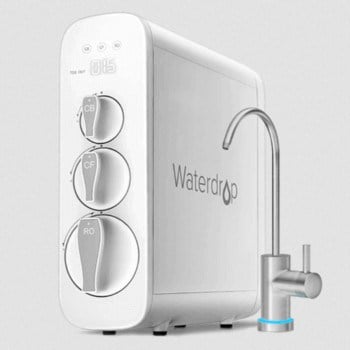
Waterdop’s premium seven-stage filtration system removes more than 90-percent of more than a thousand contaminants from lead and chlorine to bacteria and PFOA.
Fifty percent smaller than conventional RO filters, it fits conveniently under any kitchen sink.
We’ve had ours for 3 months and love it!
- Space-saving design
- Lifetime warranty
- Low wastewater ratio
- Brisk flow rate
- NSF/ANSI standards 58 and 372 certified
- Straightforward DIY-installation
Qualitywaterlab readers get 10% off using coupon code: QWL-10OFF
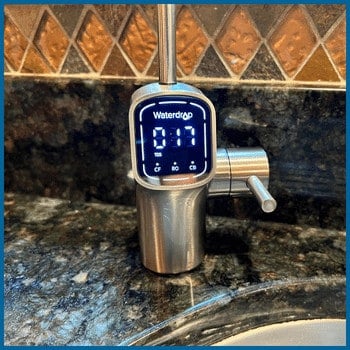
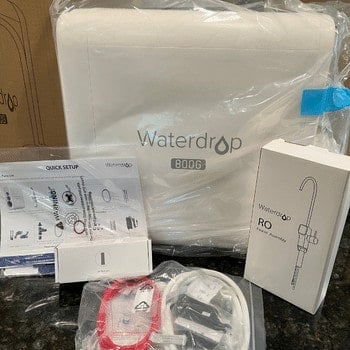
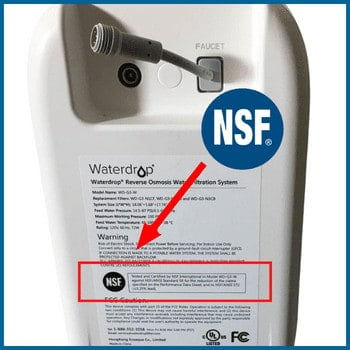
Perfect for: This system is the best point-of-use (POU) undersink filtration system that will eliminate lead among other harmful chemicals from your water – great for apartment renters.
Pros
- Simple to install with an environmentally friendly 1:1 wastewater ratio, maintenance is a breeze and replacement cartridges are surprisingly affordable.
- Performance certified, it includes your choice of a chrome or brushed nickel dispensing faucet.
- The filters a pretty easy to change and comes with three twist-and-pull filters.
- Change the CF cartridge every six months, the CB filter annually and the RO membrane every two years — It’s mess-free and takes only seconds.
- This system will not impact water pressure and you can fill a cup in less than 10 seconds.
- Waterdrop features an internal pump that boosts the flow rate to 0.28 gallons per minute — among the fastest in the industry.
- Reverse osmosis filters are among the most effective for removing lead.
- Traditional RO systems are bulky and the tankless design on the Waterdrop G3 solves that problem and more.
- Providing up to 800 gallons per day of fresh, crystal-clear drinking water while using less counter or undersink storage space.
- Thoughtfully engineered and user-friendly, there’s no excuse to drink lead again.
- The system can also be connected to your refrigerator by adding Waterdrops’s 1/4-inch water line connection kit.
Cons
- Limited 1-year warranty
#3. Big Berkey Water Filter 2.25 Gallon Countertop Water Filter
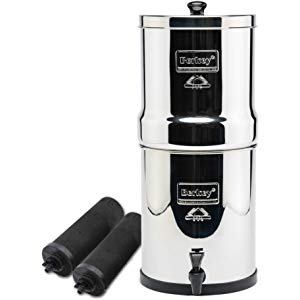
Berkey is a trusted name in water filtration, producing some of the industry’s leading countertop filters.
Gravity-fed, its flagship Big Berkey removes 200-plus dangerous contaminants from pesticides to heavy metals without electricity or waste.
Independent testing shows it eliminates 95-100 percent of lead depending on which filter set is used.
- Fast, on-demand filtration
- Comprehensive lead removal
- Attractive stainless steel finish
- Portable
- UV Filtration (optional add on)
- Works without electricity in a power outage
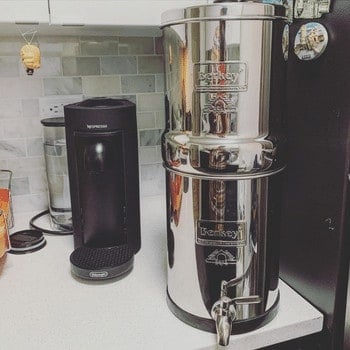
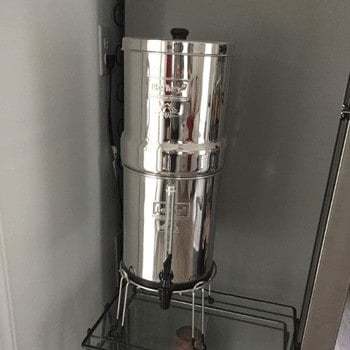
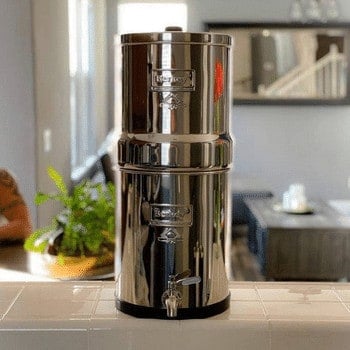
Perfect For: This is perfect for renters, emergencies, and traveling — the water tastes great!
Pros
- Small space-friendly and portable, it boasts a lean 8.5-inches footprint and durable stainless steel exterior.
- The reservoir holds 2.25 gallons — pour water in the top to produce more on-demand.
- Berkey water filters are a low-tech but comprehensive approach to lead filtration.
- The manual loading and limited capacity are a turn-off for some buyers but consider the benefits.
- If you live in an outage-prone area, it works without electricity. Ideal for a crisis preparedness kit, it takes less than a square foot to store but can meet water demand for a family.
- What it lacks in panache it makes up for in versatility — have one on hand for emergencies.
- Berkey products are tested by multiple independent laboratories, but the company believes the certification process is too costly and would unnecessarily increase the price of its filters.
- Test results are available to consumers and appear to exceed NSF standards.
- Filters need to be changed every every 6000 gallons.
- The housing is warrantied for a year — the purification elements for two.
Cons
- Not NSF certified
#4. Aquasana Claryum Direct Connect Water Filter
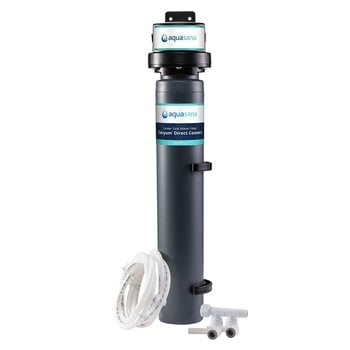
Aquasana’s Claryum line is the latest in convenience-driven performance. A powerful point-of-entry filter, it mounts under the sink and connects directly to your existing faucet.
It reduces 15 times more contaminants than the average filter pitcher, including up to 99 percent of lead.
- Impressive contaminant removal
- Works with your existing faucet
- Effortless installation
- Easy maintenance
- One-year warranty
Great For: This is perfect for those that aren’t very handy and want a quick reliable solution to lead.
Pros
- NSF 42, 53, 401 and P473 certified, each filter lasts six months and produces enough water to fill more than 6000 water bottles.
- Unlike RO filters, it doesn’t remove beneficial minerals, so water always tastes crisp and clean.
- No need of a power drill to connect this system and can be installed in less than 15 mins.
- If you want a quality water filter certified to remove lead that doesn’t require a special dispensing faucet, look no further.
- I challenge you to find a model that removes as many contaminants for the price.
- The filtration kit includes a filter housing, one cartridge and everything required for installation, including an adapter for 3/8-inch hoses.
Cons
- There have been a few complaints that it reduces water pressure more than expected, and it may.
#5. PUR Faucet Water Filtration System
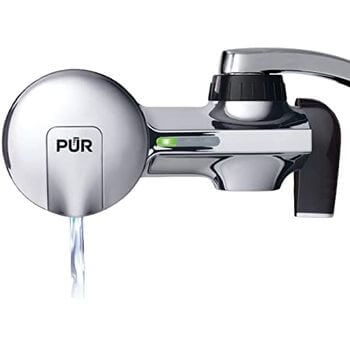
PUR lives up to its name with this NSF-certified filter that virtually eliminates more than 70 contaminants including 99-percent of lead.
With features that rival systems twice the cost, it fits any standard faucet.
- Quality lead filtration
- Installs in minutes
- Filter change indicator
- Backed by a 6-month money back guarantee
- Sleek, low-profile design
- Competitive price
Great for: This a perfect budget friendly solution for renters to remove lead with a quick installation.
Pros
- Switch effortlessly between filtered and unfiltered water for washing dishes to preserve the life of your filter.
- PUR’s patented Mineral Core reduces toxins without removing the healthy minerals that make water so refreshing.
- No faucet filter removes as much lead as a reverse osmosis system. But the PUR is among the few I trust with kids in the house — it has the NSF seal of approval.
- The filter life is short, and it costs a little more than the competition, but it’s still affordable and has a sophisticated look that blends better into modern kitchens.
- Quality-built, you can trust your water to PUR — it’s the best faucet filter to remove lead.
- The faucet mount and housing can be used indefinitely. Replaceable filters last for 3 months or 100 gallons.
- Filters come with three adapters that fit 95-percent of all standard faucets.
- One of three additional adapters may be ordered free of charge for less common models.
Cons
- Limited filter life
#6. Epic Pure Water Filter Pitcher
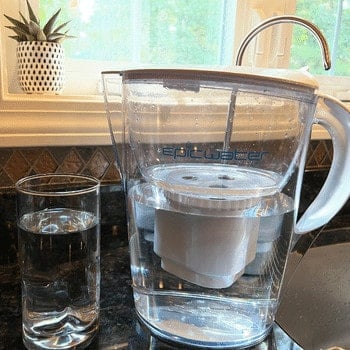
The Epic Pure filter eliminates up to 99.99% percent of more than 200 hazardous substances, including lead — 3000% more contaminants than the leading pitcher.
Each is rigorously tested to meet or exceed NSF 42, 53, 401 and P478 standards.
- Removes more than 97 percent of lead
- Space-saving design
- Filter life indicator
- Made of BPA-free, 100-percent recyclable plastic
- Limited lifetime warranty
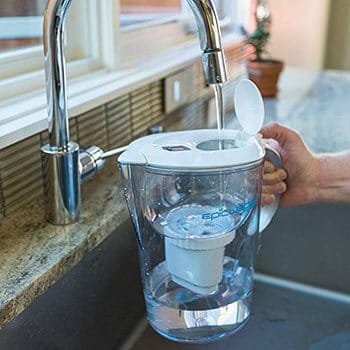

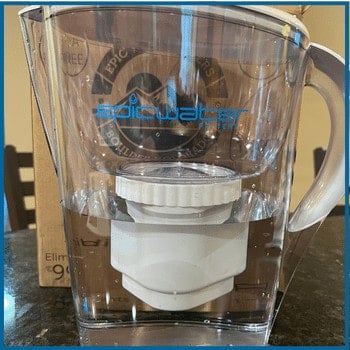
Perfect for: Anyone looking for a simple cost effective solution to lead should choose a Epic water filter pitcher.
Pros
- Selective filtration technology removes toxins while preserving the healthy minerals that make water refreshing.
- BPA-free, the sturdy Tritan pitcher holds a generous two liters.
- Engineered for durability and convenience, it’s a cinch to fill and virtually spill-proof.
- This pitcher will filter a full pitcher in just over a minute.
- Epic Pure pitchers eliminate the most worrisome contaminants in water while refining its taste.
- They’re well-balanced, pour perfectly and hold enough to serve a family at mealtime.
- Despite their limited capacity, they’re among the top water filtration systems for lead.
- Twice the price of garden-variety pitchers but half the cost of entry-level undersink or countertop filters, they’re an excellent value when every penny counts.
- Filters last 3-4 months depending on your water quality.
- Epic filter pitchers don’t remove healthy minerals which are most of the dissolved solids in water (TDS).
- This pitcher can be used with well water, but it doesn’t remove bacteria or parasites. The Epic Pure Nano pitcher is a better choice.
Cons
- Not dishwasher-safe, so you need to hand-wash this pitcher.
#7. AquaTru Reverse Osmosis Countertop Water Filtration System
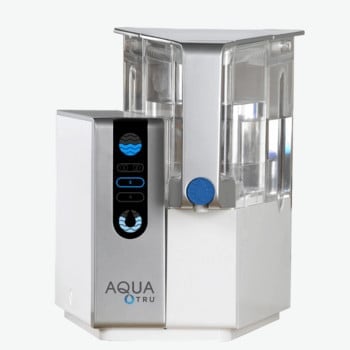
AquaTru filters feature a patented four-stage filtration system that removes 82 hazardous contaminants, including chlorine, arsenic, nitrates and lead.
Certified by the IAPMO to NSF 42,53,58, and 401 standards, water tastes better than bottled.
- Removes stubborn contaminants
- Easy filter changes
- Affordable replacement filters
- 30-day satisfaction guarantee
Great for: This is a perfect choice for those wanting a reverse osmosis system without dealing with a permanent installation – sits right on your countertop and is simple to use.
Pros
- Compact, it requires just 14 square inches of counter space, yet it holds three full quarts of purified water. T
- he reservoir is removable and can be stored in the refrigerator.
- Dispense a fresh cup with the push of a button — it’s safe and easy for the kids to use.
- Aquatru’s filtration system isn’t cheap, but it’s portable, and eliminates as many dangerous toxins as systems twice the price.
- Each set of affordably-priced filters replaces 4500 plastic water bottles for savings that easily offset their cost.
- With 50-percent more capacity than the average filter pitcher, it’s an excellent choice for small families with big lead problems.
- The Aquatru has three filters. The prefilter lasts 6 months. The VOC cartridge lasts a year, and the RO filter is effective for 2 years or more.
- Both the tap water tank and the purified water reservoirs are made of BPA- and BPS-free, shatter-resistant Tritan plastic.
Cons
- Requires electricity
- Prone to leaking if the pitcher isn’t properly seated in the base.
- Like most RO filters, it eliminates most dissolved solids, including minerals
#8. Aquasana OptimH2O Reverse Osmosis + Claryum Water Filter
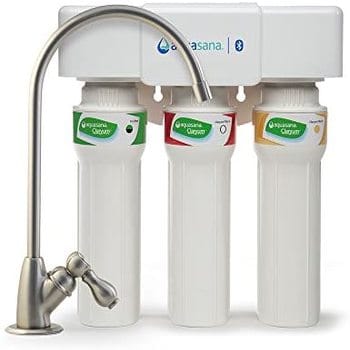
Aquasansa’s latest undersink filtration system removes five times more contaminants than other lead water filters but without removing beneficial minerals — a rare find in a reverse osmosis system.
Claryum technology purifies water faster, improving the flow rate at your tap.
- Removes stubborn contaminants
- Simple DIY installation
- Low-maintenance
- Brisk flow rate
- Two-year warranty
Perfect For: This is a great undersink filter that handles Lead with ease and is budget friendly.
Pros
- NSF certified to standards 42, 53 and 401, it eliminates up to 99-percent of lead and more.
- The kit includes the filters, undersink storage tank and a chrome, bronze or brushed nickel dispensing faucet.
- Risk-free, it’s backed by a 90-day satisfaction guarantee.
- If you need comprehensive filtration for tough-to-remove contaminants but don’t like the flavor of water from conventional RO systems, you’ll be delighted with this filter.
- Water tastes like it came from a fancy French bottle for a fraction of cost.
- Wallet-friendly, the long-term cost of ownership is rock bottom, so you don’t have to choose between your health and your budget.
- This is the only RO system that doesn’t remove healthy minerals and remineralization filter adds them back.
- The Claryum carbon filter lasts six months. The RO and remineralization cartridges are replaced annually.
Cons
- Noisy when the tank refills
Compare All 8 Water Filters For Lead
(Mobile users: Swipe to scroll) Compare Brands & Models
Compare Brands & Models
|
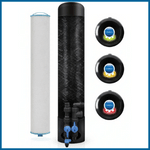 #1 SpringWell Lead & Cyst
#1 SpringWell Lead & Cyst |
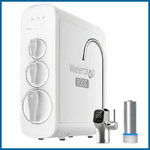 #2 WaterDrop G3P800 System
#2 WaterDrop G3P800 System |
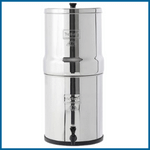 #3 Big Berkey Countertop Filter
#3 Big Berkey Countertop Filter |
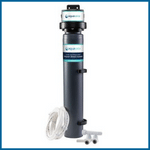 #4 Aquasana Claryum Filter
#4 Aquasana Claryum Filter |
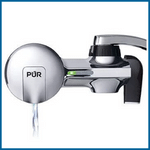 #5 PUR Faucet Filter System
#5 PUR Faucet Filter System |
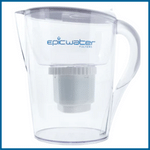 #6 Epic Pure Filter Pitcher
#6 Epic Pure Filter Pitcher |
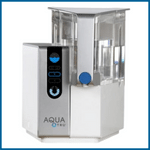 #7 AquaTru RO System
#7 AquaTru RO System |
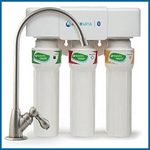 #8 Aquasana OptimH20 Filter
#8 Aquasana OptimH20 Filter |
|---|---|---|---|---|---|---|---|---|
| Rating | 5/5 | 5/5 | 4.5/5 | 4.5/5 | 4.5/5 | 4.5/5 | 5/5 | 5/5 |
| Price | $$$ | $$$ | $$ | $$ | $ | $ | $$ | $$$ |
| Pb Reduction | 99.95% | 99.99% | 97.5% | 99% | 99% | 99.99% | 99.1% | 99% |
| Contaminants Removed | 10+ | 1000+ | 200+ | 10+ | 70 | 200+ | 82+ | 88+ |
| Certifications | NSF/ANSI P473 & 53 | NSF/ANSI standards 58 & 372 | ❌ | NSF 42, 53, 401 and P473 certified | NSF 42, 53 and 401 certified | NSF 42, 53, 401 and P478 standards | NSF42, 53, 58, and 401 standards | NSF 42, 53 and 401 Standards |
| Filter Life | 100,000 gal. | 6, 12 and 24 months | 3,000 gal. | 784 gal. | 100 gal. | 150 gallons | 1,200 gal. | 6, 12 months |
| Technology | Digital | Digital | ❌ | ❌ | LED | Digital | Digital | ❌ |
| Annual Cost | ~$400 | ~$170 | ~$40 | ~$80 | ~$75 | ~$130 | ~$100 | ~$200 |
| Warranty | Lifetime | 1 Year | Lifetime | 1 Year | 2 year | Lifetime | 1 year | Lifetime |
How We Chose

Removing lead from water requires more than just a basic filter. Our search for the best lead-removing water filters was in-depth. We focused on real-world effectiveness, not just listed features or certifications. We delved into user reviews and independent tests.
Our goal: find filters that excel in lead reduction and are easy to use. Only after personally testing these filters and ensuring their effectiveness in lead removal did we feel confident to recommend them. If we wouldn’t trust them for our own families, they didn’t make our list.
Who Needs This Guide?
This guide is essential for anyone concerned about lead in their water supply.
Within these pages, you’ll discover:
- The dangers of lead in water
- How lead enters our water systems
- The impact of lead on health
- Effective strategies for lead removal
We aim to simplify complex technical terms and clarify misleading marketing claims.
Additionally, we cover:
- The various types of lead water filters
- Key features to consider in a lead filter
- Budgeting for a quality lead filter
If you’re seeking answers about lead filtration, you’re in the right place
Buyer’s Guide
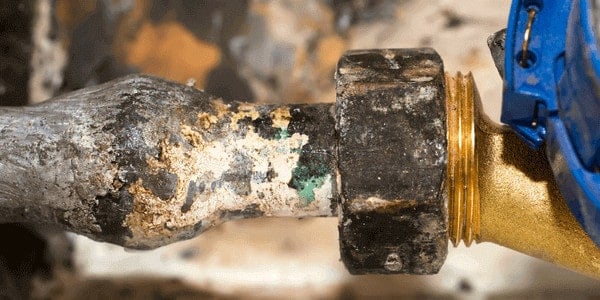
Lead can be a blessing or a curse. It powers our batteries, shields us from x-rays and waterproofs our roofs – but in drinking water it can be deadly. More than 9 million US homes are at risk of contamination, with no easy public solution. The only way to protect your family is through home water filtration.
Let’s explore the dangers of lead and the best ways to filter and remove lead from our water supply.
What Is Lead?
Lead is a heavy metal: soft, silvery-blue and found naturally in Earth’s crust – valued by manufacturers for its density.
How Does Lead Get Into Water?
Lead rarely occurs in source water like rivers or lakes; instead it enters via aging service lines, pre-90s well seals & pumps containing lead parts, old plumbing fixtures & solder (up to 8% legally until 2014). In 2014 Flint Michigan authorities failed to add corrosion inhibitors exposing thousands to dangerous levels of lead – since then dozens more cities have been found.
Key Considerations

Elevate your home’s water safety with the ideal lead-removing water filter by embarking on these three essential steps:
Step 1: Uncover Your Water’s Hidden Elements
City water quality can harbor hidden dangers, with lead silently infiltrating the water supply as it traverses through aging infrastructure. Discover the hidden story of your water with these methods:
- Consult the Professionals: Contact your local water authorities. They provide detailed annual water quality reports for your area — a valuable, free tool to show any lurking lead levels.
- Do-It-Yourself Testing: No technical expertise required. Acquire a lead testing kit from a local hardware store or online. You can also send a water sample to a certified lab, with numerous states offering free testing to residents.
Why It Matters: Unveiling the secrets in your water is vital for ensuring your family’s safety. Detecting lead is the first step towards making informed decisions about the necessity and type of water filter you need.
Step 2: Opt for Optimal Filter Size and Type
Ensuring you have the right size and type of filter is paramount. Here’s how to ensure a perfect fit:
- Evaluate the Lead Levels: Based on your water’s lead content, determine the filter’s required capacity and specifications.
- Calculate the Size: Consider your household size and daily water usage to ascertain the appropriate filter size and capacity.
Example: For a family of four with significant daily water use and high lead levels, a heavy-duty, certified lead-removing filter is essential. Ensure the filter is approved for lead removal and is adequate for your household size and water consumption.
Step 3: Understand the Filtration Technologies
Water filters wield various technologies to extricate lead and other contaminants:
- Activated Carbon: Efficient for lead reduction, yet may require frequent filter replacement.
- Reverse Osmosis: Highly effective, but may reduce beneficial minerals and should be used as a POU (point-of-use) under a kitchen sink for drinking water usage.
- Distillation: Distillation is the oldest method of water purification. Steam from boiling water is captured and condensed, dripping into a reservoir as it returns to liquid form. Water is 99.9% pure, but there’s a catch — it can take hours to produce a single gallon..
Choose your filtration technology prudently, ensuring it is aligned with your specific needs for lead removal and is certified for effectiveness. For many homes, a combination of technologies, such as activated carbon followed by reverse osmosis, offers comprehensive lead removal and water purification.
Before You Buy

Before you invest in a water filter for lead removal, take a moment to read these essential tips. We believe that being well-informed is crucial for a satisfactory purchase and effective lead removal. Below are the key factors to keep in mind:
- Lead Removal Efficiency: Opt for water filters proven and certified to eliminate or substantially reduce lead from water to ensure the utmost safety for your household.
- Filter Type and Technology: Explore and choose from various technologies like activated carbon, reverse osmosis, or KDF filtration types, which are known for their efficiency in lead removal.
- Flow Rate: Ensure the filter maintains a practical flow rate to avoid disruptions in daily water usage while effectively removing lead contaminants.
- Size and Compatibility: Select a filter that fits your household size and plumbing system, ensuring optimal performance and compatibility.
- Certifications: Look for filters certified by reputable organizations such as NSF International, guaranteeing their effectiveness in lead removal and adherence to safety standards.
- Installation and Maintenance: Give preference to filters that are easy to install and maintain, ensuring consistent and hassle-free operation over time.
- Cost and Long-Term Expenses: Consider not only the initial investment but also the long-term expenses, ensuring the filter offers good value for money and affordability in maintenance.
- Customer Support and Warranty: Ensure your investment is backed by robust customer support and a comprehensive warranty, providing peace of mind and assistance whenever needed.
Installation & Maintenance Tips
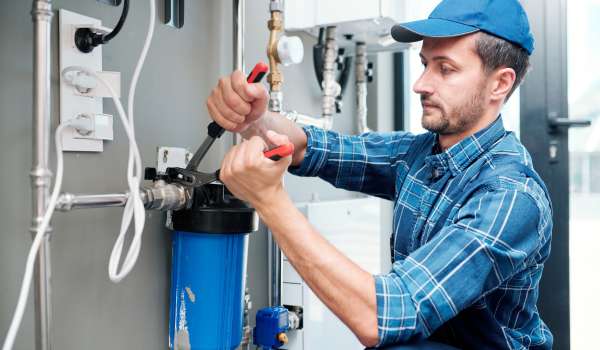
Installing a lead-removing water filter is key for clean water. Let us guide you through setup and maintenance for the best results.
Step-by-step guide on filter installation
- Begin by turning off the main water supply to your home, prioritizing safety.
- Locate the cold-water line under your sink or near the desired point of use for installing the filter.
- Use a pipe cutter to carefully cut into the cold-water line, allowing ample space for accommodating the filter housing.
- Attach fittings provided with your top-of-the-line water filter kit onto both ends of the cut pipe.
- Connect one end of the cut pipe securely to the inlet side of the filter housing.
- Ensure a tight connection by attaching another piece of tubing from the outlet side of the filter housing back into your plumbing system.
- Turn on your main water supply and meticulously check for any leaks. If there are no leaks present, congratulations! You have successfully installed your high-performance water filter.
Expert tips on maintaining peak performance
- Regularly clean or replace pre-filter cartridges if applicable. This proactive measure prevents clogging and ensures efficient filtration at all times.
- Adhere strictly to manufacturer’s guidelines regarding replacement intervals for different components such as carbon filters or membranes – these guidelines are designed specifically for maximum effectiveness.
- Keep track diligently: Mark down when you last replaced each component on a calendar or set reminders on your phone so that you never miss an important maintenance task again!
- During routine maintenance checks, thoroughly clean all parts involved in order to eliminate any buildup that may compromise filtration efficiency – this will keep everything running smoothly.
Knowing when and how to replace filters like an expert
The frequency at which you should replace your water filters depends on several factors, including usage, incoming water quality, and the type of filtration system employed. However, here are some general guidelines to follow:
- Carbon filters: Typically, these require replacement every 6-12 months based on usage and water quality – ensuring consistent performance.
- Reverse osmosis membranes: These remarkable components usually last 2-3 years but may necessitate more frequent replacement in areas with high levels of contaminants – guaranteeing maximum purification.
- Pre-filters: Replace these as recommended by the manufacturer or when you observe a decrease in water flow – maintaining optimal filtration efficiency.
Always remember to consult the specific instructions provided by your trusted filter manufacturer for accurate maintenance and replacement guidelines tailored to your particular model.
By following our expert installation and maintenance tips, you can rest assured that your chosen water filter will operate at its highest capacity. Enjoy clean and safe drinking water that is free from harmful lead contaminants thanks to our exceptional filtering solutions.
Our Final Thoughts
You surely want to feel confident and satisfied with your choice of a lead-removing water filter. Making an informed decision guarantees not just value for your money but, more importantly, the safety and well-being of your household.
Review the options, consider your specific needs, and opt for a filter that stands up to the critical task of effective lead removal. Ensure your water is not just clear, but purely safe, free from the silent and harmful intrusion of lead.
FAQ’s

Boiling water doesn’t remove it lead — it concentrates it. As water evaporates, the ratio of lead to the water remaining rises. Boiling is different than distillation which captures the steam.
Does reverse osmosis remove lead from water?
Reverse osmosis removes 99-percent of lead or more. When combined with a carbon filter, it’s the best protection money can buy.
Refrigerator filters are granular activated carbon (GAC), or charcoal filters. Useful in refrigerators because they don’t affect water pressure, they do not remove lead.
Lead in groundwater is rare, but wells and well pumps built before the 1990s could have lead components.
Dissolved lead is colorless, odorless and tasteless. Without a test, you’ll never know it’s lurking in your water.
 142 people found this helpful. Was this guide helpful to you?
142 people found this helpful. Was this guide helpful to you? 
